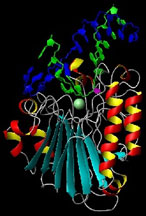Department of Biochemistry & Molecular Biology; Sealy Center for Structural Biology & Molecular Biophysics
Route: 0304 | Tel: (409) 747-6810 | webraun@utmb.edu
Research Experts
Education and Training
BS in Theoretical Physics, ETH Zürich, Zürich, Switzerland
PhD in Theoretical Physics, ETH Zürich, Zürich, Switzerland
Post-Doctoral Research Associate, ETH Zürich, (Kurt Wüthrich)
Post-Doctoral Research Associate, Kyushu University, (Nobuhiro Gō)
Biography
Werner Braun is Professor in the Department of Biochemistry and Molecular Biology at the University of Texas Medical Branch (UTMB) in Galveston, Texas. He received his academic and professional training at the ETH in Zürich, Switzerland. After 1982 Dr. Braun spent two years at Kyushu University, Fukuoka, Japan, as a research fellow of the Japanese Society for the Promotion of Science in the group of Dr. Nobuhiro Gō. In 1984 he returned as an Oberassistent to Dr. Wüthrich’s laboratory at the ETH and was promoted in 1987 to Privatdozent for Biophysics. In 1995 he was recruited as Professor and core member of the Sealy Center for Structural Biology at UTMB Galveston. In recognition of his excellent scientific achievements, he was elected in 2007 nationally as an AAAS Fellow (American Association for the Advancement of Science); a distinction conferred annually upon selected AAAS members by their peers. Several federal agencies, among them the NIH, the US FDA and the US EPA, supported his basic science research. He served on numerous review panels for the NIH and NSF, and was a member of the FIFRA Scientific Advisory Panel of the US EPA to provide recommendations for the EPA to establish regulatory guidelines to assess the potential allergenicity of novel plant products.
Research Interests
The long term goal of Dr. Braun’s research is to understand the molecular mechanisms for the function and antigenic properties of proteins by analyzing the increasing amount of data from genomics, proteomics and metabolomics databases with novel bioinformatics tools.>
Specific Projects
 (I) Development of software tools for the prediction of conformational epitopes. Precise determination of conformational epitopes of neutralizing antibodies represents a key step in the rational design of novel vaccines and to understand the molecular mechanisms of allergenic reactions to proteins. New developments include prediction of conformational epitopes from 3D structures in a new version of InterProSurf, differential sequence analysis by our PCPMer software suite, and a new software Cross-React to predict molecular IgE cross-reactivity among allergenic proteins. These software tools are applied to assess the potential allergenicity of proteins and to the design of novel vaccine candidates of emerging infectious diseases.
(I) Development of software tools for the prediction of conformational epitopes. Precise determination of conformational epitopes of neutralizing antibodies represents a key step in the rational design of novel vaccines and to understand the molecular mechanisms of allergenic reactions to proteins. New developments include prediction of conformational epitopes from 3D structures in a new version of InterProSurf, differential sequence analysis by our PCPMer software suite, and a new software Cross-React to predict molecular IgE cross-reactivity among allergenic proteins. These software tools are applied to assess the potential allergenicity of proteins and to the design of novel vaccine candidates of emerging infectious diseases.
(II) Structural biology of allergens. Understanding the characteristics of allergenic proteins is important for guiding the treatment of patients, for reducing allergens in our food and air, and eventually for designing hypoallergenic proteins for use in foods and immunotherapy. Recent progress on the biochemical classification and 3D-structure determination of allergenic proteins and allergen-IgE complexes has enhanced our understanding of the molecular determinants of allergenicity. His research group established a Structural Database of Allergenic Proteins (SDAP) that provides rapid, cross-referenced access to sequences, structures, and IgE epitopes of more than 900 allergens. In a recent study the computational tools were applied to determine new conformational IgE epitopes of the peanut allergens Ara h 2 and Ara h 6 in a collaboration with Dr. Dreskin (UC Denver).
(III) Structural studies on envelope proteins of encephalitic and arthralgic alphaviruses. Alphaviruses, which include the encephalitic Eastern (EEEV), Western (WEEV) and Venezuelan Equine Encephalitis virus (VEEV) and the arthralgic chikungunya virus (CHIKV), cause significant disease in humans in all parts of the world and represent serious biological threats. In collaboration with Dr. Weaver at UTMB his group used his validated structural and computational tools to design a broad-spectrum vaccine against the CHIKV and VEEV alphaviruses. The results of this project will also have impact on the design of new vaccines for other viruses. Several constructs of vaccine candidates are currently in the experimental test phase.
(IV) Computational tools to assess the risk of potential toxic effects of proteins. Our goal is to provide novel, validated methods to rapidly assess the similarity of a novel protein to known protein toxins. This will allow biotechnology companies to evaluate the potential for adverse effect of novel engineered proteins early in the development cycle and mitigate the effect by specific amino acid substitutions. The quantitative analysis can also be used as supporting material for the endorsement of a final product to regulatory agencies.